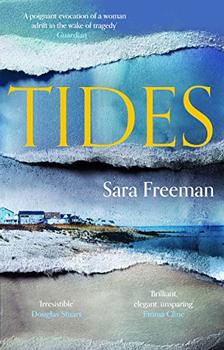Summary | Excerpt | Reviews | Beyond the Book | Read-Alikes | Genres & Themes | Author Bio

This article relates to Tides
 In Sara Freeman's debut novel Tides, after undergoing a harrowing loss, the protagonist Mara takes to the road, leaving everything and everyone she loves behind. She doesn't know where she will go, but if asked, she knows she will say, "without hesitation, [t]he sea." She is drawn to a town — any town — by the sea because her mother hails from such a place. For Mara, the sea is the origin point of her "self."
In Sara Freeman's debut novel Tides, after undergoing a harrowing loss, the protagonist Mara takes to the road, leaving everything and everyone she loves behind. She doesn't know where she will go, but if asked, she knows she will say, "without hesitation, [t]he sea." She is drawn to a town — any town — by the sea because her mother hails from such a place. For Mara, the sea is the origin point of her "self."
According to literary theorist Dr. Viola Parente-Čapková, in many cultures, water "has been traditionally connected with life, birth and re-birth, creation and creativity, but also with death and oblivion." In literature, water appears as a vital life force to be reckoned with (such as in Homer's Odyssey); as an element that facilitates a renewed, free life (as in The Adventures of Huckleberry Finn by Mark Twain); or as an agent that cleanses, clarifies and purifies, a notion explored in the Bible in addition to many other texts.
Water is also used symbolically as a life-giving resource, both because it is essential to human life and because of the womb's amniotic fluid. But when these conventional, even orthodox ideas linking water and femininity are subverted and repurposed in books, especially those written by women, one often finds a feminist approach to the healing, creative and rebirthing properties of water. Literature of this kind deploys water imagery to garner a distinct, rich feminist meaning.
Take for instance Kate Chopin's novel The Awakening. Trapped in domesticity and patriarchal notions of womanhood, the protagonist Edna's gateway to a renewed self is through the water. Her "awakening" occurs when she is at the beach, where she realizes she can be more than just a wife and mother. Edna drowns at the end of the novel, but her death in the water represents a rejection of, and freedom from, these stifling normative roles.
A kind of transformation through water occurs for the unnamed narrator in Margaret Atwood's Surfacing as well. On the search for her missing father near his cabin, the narrator takes a solo dive into a pool. The contact with deep water allows her unconscious self to surface, ready for a reconnection, thereby making way for a metamorphosis, or a kind of rebirth.
Water and water imagery have also been used to suggest boundaries. But in feminist interpretations, these boundaries may represent structures that are ultimately transgressed. In Arundhati Roy's The God of Small Things, the mother of twins Rahel and Estha crosses the river to meet her lover Velutha, whom she as an upper caste woman is not even supposed to touch. In Toni Morrison's Beloved, meanwhile, the crossing of the Ohio River signifies freedom for Sethe, in a literal sense from enslavement, but also from a horrible act she committed. It is opportune and poignant that the embodiment of that horrible act actually emerges from the water as well, in the form of the adolescent Beloved.
These interpretations stand in stark contrast with the "Lady of the Lake" motif, an established device in classic literature. This theme depicts beautiful, mad women, who are dead or dying in some way relating to water. Self-sacrificing, suicidal ladies such as Hamlet's Ophelia and Alfred Lord Tennyson's "Lady of Shallot" symbolize purity, innocence and male devotion, and are hardly ever given agency of their own.
Filed under Reading Lists
![]() This "beyond the book article" relates to Tides. It originally ran in February 2022 and has been updated for the
January 2023 paperback edition.
Go to magazine.
This "beyond the book article" relates to Tides. It originally ran in February 2022 and has been updated for the
January 2023 paperback edition.
Go to magazine.
Your guide toexceptional books
BookBrowse seeks out and recommends the best in contemporary fiction and nonfiction—books that not only engage and entertain but also deepen our understanding of ourselves and the world around us.